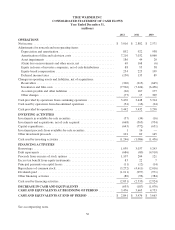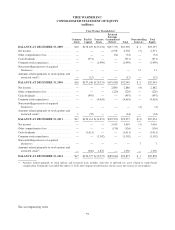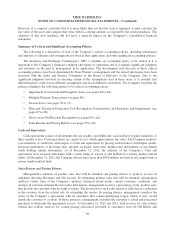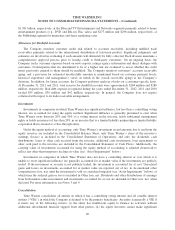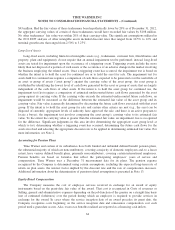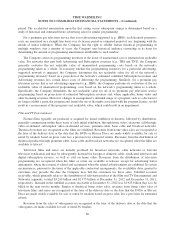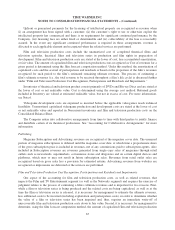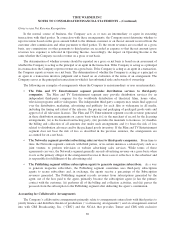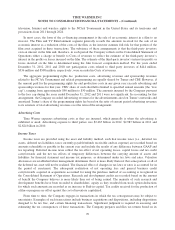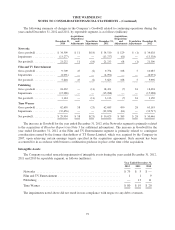Time Magazine 2012 Annual Report Download - page 82
Download and view the complete annual report
Please find page 82 of the 2012 Time Magazine annual report below. You can navigate through the pages in the report by either clicking on the pages listed below, or by using the keyword search tool below to find specific information within the annual report.TIME WARNER INC.
NOTES TO CONSOLIDATED FINANCIAL STATEMENTS – (Continued)
period. The accelerated amortization upon the first airing versus subsequent airings is determined based on a
study of historical and estimated future advertising sales for similar programming.
For a premium pay television service that is not advertising-supported (e.g., HBO), each licensed program’s
costs are amortized on a straight-line basis over its license period or estimated period of use, beginning with the
month of initial exhibition. When the Company has the right to exhibit feature theatrical programming in
multiple windows over a number of years, the Company uses historical audience viewership as its basis for
determining the amount of programming amortization attributable to each window.
The Company carries its programming inventory at the lower of unamortized cost or estimated net realizable
value. For networks that earn both Advertising and Subscription revenues (e.g., TBS and TNT), the Company
generally evaluates the net realizable value of unamortized programming costs based on the network’s
programming taken as a whole. In assessing whether the programming inventory for a particular advertising-
supported network is impaired, the Company determines the net realizable value for all of the network’s
programming inventory based on a projection of the network’s estimated combined Subscription revenues and
Advertising revenues less certain direct costs of delivering the programming. Similarly, for a premium pay
television service that is not advertising-supported (e.g., HBO), the Company performs its evaluation of the net
realizable value of unamortized programming costs based on the network’s programming taken as a whole.
Specifically, the Company determines the net realizable value for all of its premium pay television service
programming based on projections of estimated Subscription revenues and, where applicable, home video and
other licensing revenues. However, changes in management’s intended usage of a program, such as a decision to
no longer exhibit a particular program and forego the use of the rights associated with the program license, would
result in a reassessment of that program’s net realizable value, which could result in an impairment.
Film and TV Entertainment
Feature films typically are produced or acquired for initial exhibition in theaters, followed by distribution,
generally commencing within three years of such initial exhibition, through home video, electronic sell-through,
video-on-demand, subscription video-on-demand services, premium cable, basic cable and broadcast networks.
Theatrical revenues are recognized as the films are exhibited. Revenues from home video sales are recognized at
the later of the delivery date or the date that the DVDs or Blu-ray Discs are made widely available for sale or
rental by retailers based on gross sales less a provision for estimated returns. Revenues from the distribution of
theatrical product through premium cable, basic cable and broadcast networks are recognized when the films are
available to telecast.
Television films and series are initially produced for broadcast networks, cable networks or first-run
television syndication and may be subsequently licensed for foreign or domestic cable, syndicated television and
digital subscription services, as well as sold on home video. Revenues from the distribution of television
programming are recognized when the films or series are available to telecast, except for advertising barter
agreements, where the revenue is valued and recognized when the related advertisements are exhibited. In certain
circumstances, pursuant to the terms of the applicable contractual arrangements, the availability dates granted to
customers may precede the date the Company may bill the customers for these sales. Unbilled accounts
receivable, which primarily relate to the distribution of television product at the Film and TV Entertainment and
Networks segments, totaled $3.210 billion and $2.975 billion at December 31, 2012 and December 31, 2011,
respectively. Included in the unbilled accounts receivable at December 31, 2012 was $1.925 billion that is to be
billed in the next twelve months. Similar to theatrical home video sales, revenues from home video sales of
television films and series are recognized at the later of the delivery date or the date that the DVDs or Blu-ray
Discs are made widely available for sale or rental by retailers based on gross sales less a provision for estimated
returns.
Revenues from the sales of videogames are recognized at the later of the delivery date or the date that the
videogames are made available for sale or rental by retailers.
66


